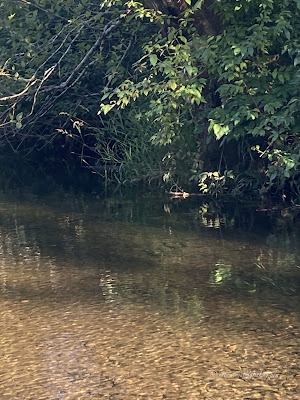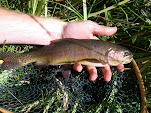Day 3: Sunday July 3rd 2022: After an extremely long, and overall successful first day of angling, we were a bit more sluggish breaking camp than I would have liked. The reason that I was anxious to get on the road again was that we had a lot of ground to cover in a single day, fishing two streams before ending up in Winnemucca, NV for the night. While originally I had just planned on fishing a single stream Steve had told me about a stream with Tiger Trout. Tiger Trout are a bit of a frankenfish, being a hybrid cross between Brook Trout and Brown Trout and as I had never caught one I was intrigued enough to check the creek out.
Although we were still slightly behind schedule we made good timing getting to the stream and arrived by mid morning. The creek was similar in size to the Bonneville Cutthroat stream from the day before, but flowed through a tunnel of Willow in the midst of the treeless sage brush desert.
While we were rigging up for the day, a local indicated two things that didn’t bode well in my opinion. First was that otters and anglers had been very effective at harvesting fish from the creek, so hold overs would be few and far between. The second was that the creek had just been stocked for the 4th of July weekend. While in theory this meant more fish, the influx of fish was likely to disrupt the existing fish community and the new stockers would be unlikely to be used to natural prey sources. So normal tactics might not be very effective.
 |
| The Tiger Trout stream |
While the stream looked like it should be quite productive, with lush aquatic vegetation good holes and a few beaver ponds, few of the likely lies showed any sign of fish. When I did manage to spot some fish they showed very little interest in flies.
 |
| Streamside cacti |
I figure that sometimes persistence pays off and as I continued working upstream I did manage to get some takes but just couldn’t get a solid hookup with any of the fish. Most of these fish were on either dries stripped under the surface or nymphs jigged in the deep holes. It wasn’t until I found a fishy looking undercut back that I finally got a solid grab on my dropper. It was a small fish and I quickly was able to net my first Tiger Trout.
 |
| My first Tiger Trout |
I continued fishing upstream and didn’t find any additional trout, but when I met up with Derek he had managed to catch one hard won Rainbow Trout.
 |
| Derek's Rainbow Trout |
While successful, it had taken far longer for us to find fish at this stream than planned and had eaten into our time hunting for our main target of the day, the Humboldt Cutthroat significantly. It was fun to catch a new type of trout, but I couldn’t help thinking how amazing this Creek could have been if it still held the native Humboldt Cutthroat that once swam its waters. As those native Humboldts were long since gone and it was again time to hit the road and hopefully we would be able to find Humboldts in our next stream.
 |
| A lone Pronghorn Antelope on our way to the next stream |
After a few more hours on the road, with afternoon wearing on and storm clouds building on the horizon, we arrived at our second stream. I had fished this stream way back in 2006 and managed to catch a few Humboldt on that trip so I hoped trip to it would be just as successful.
I decided to head further upstream on this trip in hopes of more productive water. On my last trip I had noticed the damage the lower stream had endured from poor grazing practices and apparently the upper watershed had experienced the same damage. The stream was incised into a small a 10 foot deep trench and to make matters worse, it appeared that a fire had torn through the upper watershed recently, leaving little in the way of large vegetation.
 |
| The upper reaches of the Humboldt Cutthroat stream |
We found a spot where we could reach the stream and decided that Derek would go upstream while I went downstream. Upon reaching the of the incised canyon, it was clear that there at least had been an attempt at improving the habitat as there were numerous beaver dam analogues added to the stream. These are stakes driven into the stream bed in the hopes of attracting beavers to use them as anchor for their dams. As the beavers build their dams behind the analogues they act as sediment traps and slowly build up stream channel reversing the process of incising. Unfortunately, the fire in the upper watershed had wiped out all of the larger vegetation that beavers need to feed on and as such the intended purpose of the analogues had gone unfulfilled. While they didn't live up to their full potential, the analogues did act as decent sediment traps and instead of flowing from pool to pool, the creek flowed from one knee deep swath of quicksand after another making wading extremely very difficult. This also meant an almost complete lack of suitable habitat for trout and I only managed to hook one smaller Cutthroat that unfortunately was able to shake loose.
 |
| The deeply incised stream channel |
With the challenging and less than fruitful conditions on the upper part of the creek, Derek and I decided to head for the lower end of the watershed, where I had fished before. We were hoping that the creek in the lower reaches would be slightly larger and more productive than upstream and with luck we might find a few beaver ponds. As it turned out beaver ponds proved to be our biggest problem on the lower creek, as upon reaching the valley floor we discovered that since 2006 beavers had flooded the entire lower valley.
 |
| A beaver pond in the lower watershed |
Often beaver ponds are one of the best places to find trout on small streams, but this particular scenario was not one of those cases. The water was extremely murky and there was almost no casting room due to extremely thick vegetation growth. I was able to wade into the muck a ways and saw many fry in the 2" range (a good sign for the viability of the population), but 45 minutes of casting didn't even result in a strike. With the beaver ponds not yield results, I tried to find some flowing water, but my attempts to find a way threw the overgrown brush all proved unsuccessful. I rarely have failed to catch a native trout on a stream that I know to harbor them, but I had to accept that you can't win them all. As such with thickening storm clouds rolling in and the day already growing late, I linked back up with Derek who had just as much success as I did and we hit the road again, headed for Winnemucca, NV and some much needed rest. With one trout a piece and neither of them natives, this had been one of the rougher days of trout fishing I have had in a long while. Fortunately, I had caught Humboldt Cutthroat before and I just had to hope that the Quinn River Cutthroat I was after the next day would be far more eager.

































































